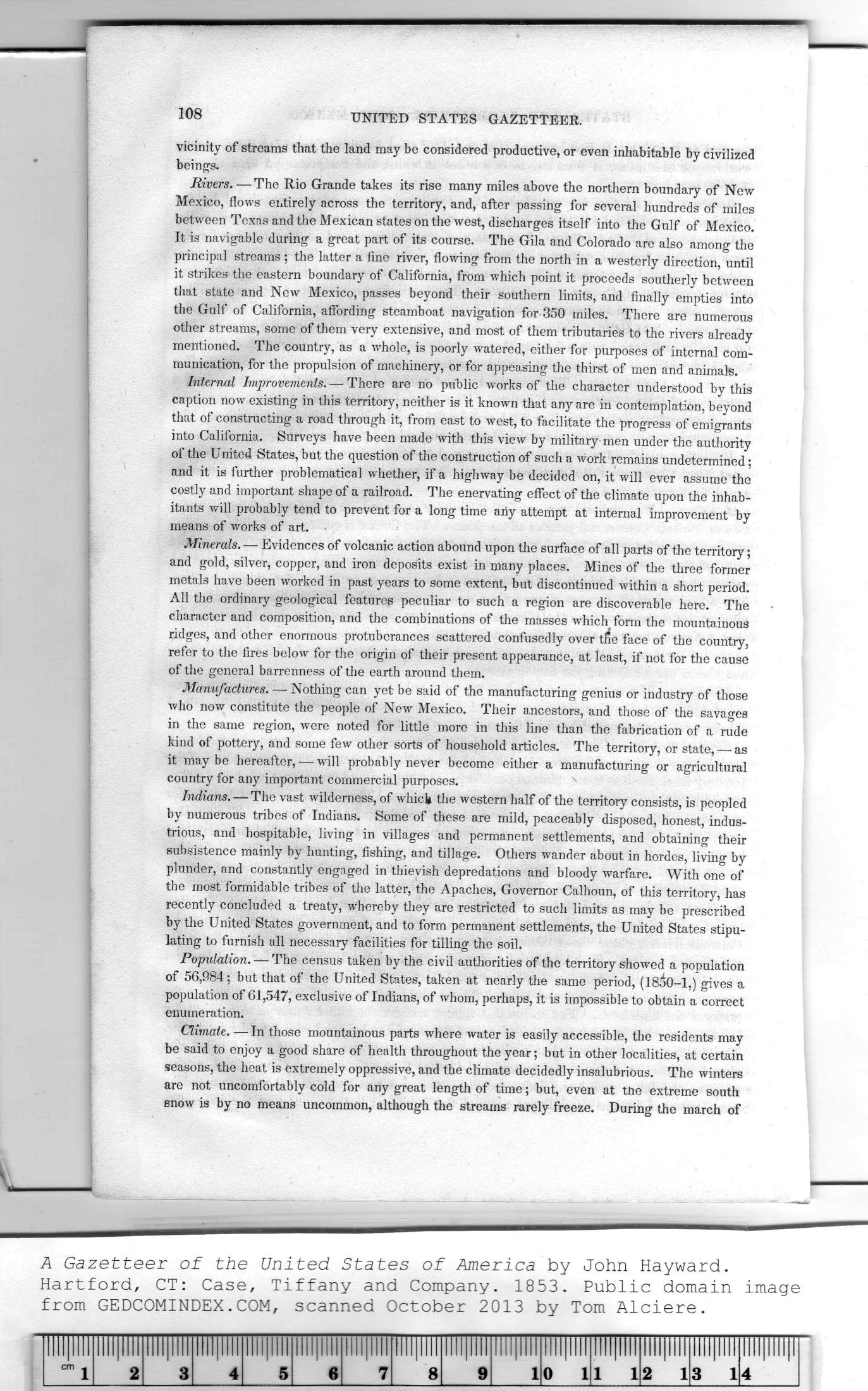|
|
Note: Ctrl and + increases the font size of the text below, Ctrl and - decreases it, and Ctrl and 0 resets it to default size.
108 UNITED STATES GAZETTEER.
vicinity of streams that the land may be considered productive, or even inhabitable by civilized
beings.
Rivers. —The Rio Grande takes its rise many miles above the northern boundary of New
Mexico, flows entirely across the territory, and, after passing for several hundreds of miles
between Texas and the Mexican states on the west, discharges itself into the Gulf of Mexico.
It is navigable during a great part of its course. The Gila and Colorado are also among the
principal streams ; the latter a fine river, flowing from the north in a westerly direction, until
it strikes the eastern boundary of California, from which point it proceeds southerly between
that state and New Mexico, passes beyond their southern limits, and finally empties into
the Gulf of California, affording steamboat navigation for 350 miles. There are numerous
other streams, some of them very extensive, and most of them tributaries to the rivers already
mentioned. The country, as a whole, is poorly watered, either for purposes of internal com-
munication, for the propulsion of machinery, or for appeasing the thirst of men and animals.
Internal Improvements. — There are no public works of the character understood by this
caption now existing in this territory, neither is it known that any are in contemplation, beyond
that of constructing a road through it, from east to west, to facilitate the progress of emigrants
into California. Surveys have been made with this view by military men under the authority
of the United States, but the question of the construction of such a work remains undetermined;
and it is further problematical whether, if a highway be decided on, it will ever assume the
costly and important shape of a railroad. The enervating effect of the climate upon the inhab-
itants will probably tend to prevent for a long time any attempt at internal improvement by
means of works of art.
Minerals. — Evidences of volcanic action abound upon the surface of all parts of the territory;
and gold, silver, copper, and iron deposits exist in many places. Mines of the three former
metals have been worked in past years to some extent, but discontinued within a short period.
All the ordinary geological features peculiar to such a region are discoverable here. The
character and composition, and the combinations of the masses which form the mountainous
ridges, and other enormous protuberances scattered confusedly over tSe face of the country,
refer to the fires below for the origin of their present appearance, at least, if not for the cause
of the general barrenness of the earth around them.
Manufactures. — Nothing can yet be said of the manufacturing genius or industry of those
who now constitute the people of New Mexico. Their ancestors, and those of the savages
in the same region, were noted for little more in this line than the fabrication of a rude
kind of pottery, and some few other sorts of household articles. The territory, or state, — as
it maybe hereafter, — will probably never become either a manufacturing or agricultural
country for any important commercial purposes.
Indians. — The vast wilderness, of which the western half of the territory consists, is peopled
by numerous tribes of Indians. Some of these are mild, peaceably disposed, honest, indus-
trious, and hospitable, living in villages and permanent settlements, and obtaining their
subsistence mainly by hunting, fishing, and tillage. Others wander about in hordes, living by
plunder, and constantly engaged in thievish depredations and bloody warfare. With one of
the most formidable tribes of the latter, the Apaches, Governor Calhoun, of this territory, has
recently concluded a treaty, whereby they are restricted to such limits as may be prescribed
by the United States government, and to form permanent settlements, the United States stipu-
lating to furnish all necessary facilities for tilling the soil.
Population. — The census taken by the civil authorities of the territory showed a population
of 56,984; but that of the United States, taken at nearly the same period, (1850-1,) gives a
population of 61,547, exclusive of Indians, of whom, perhaps, it is impossible to obtain a correct
enumeration.
Climate. — In those mountainous parts where water is easily accessible, the residents may
be said to enjoy a good share of health throughout the year; but in other localities, at certain
seasons, the heat is extremely oppressive, and the climate decidedly insalubrious. The winters
are not uncomfortably cold for any great length of time; but, even at the extreme south
snow is by no means uncommon, although the streams rarely freeze. During the march of
A Gazetteer of the United States of America by John Hayward.
Hartford, CT: Case, Tiffany and Company. 1853. Public domain image
|
